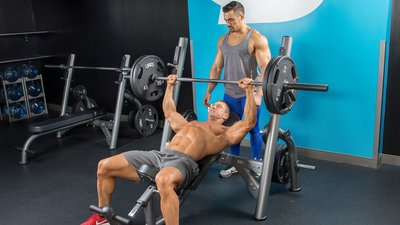"All you bro!"
If you've spent any appreciable amount of time the gym, you know the negative connotation behind this phrase. It's the call sign of some guy bench pressing either a weight he definitely can't handle on his own, or doing reps well past failure while his spotter performs an upright row.
The importance of spotting isn't talked about a lot, but it's actually a key element of productive training. People who train together on a regular basis develop a great feel for what the other person needs and is capable of, especially when those lessons are learned over the course of many training sessions.
But if you think a spotter's only job is to keep you from getting pinned, you're missing out. Here are some of my favorite ways a training partner can help make every set of your workout better.
It All Starts With Communication
Before we start laying out any intensity-boosting techniques, let's start with the most important rule of spotting: It is the responsibility of you, the lifter, to tell your spotter what you need during a set. The random gym member you asked to spot you isn't a mind reader. So just asking, "Hey bro, can you give me a spot?" isn't actually conveying very much information about what you need from them, other than standing there next to you.
Do you need a lift off? Are you doing forced reps? If so, how much should your spotter help you in order to complete those repetitions? Do you want them to "keep close" or not? For example, when I bench press, if the spotter hovers over me and keeps his hands near the bar, it throws off my concentration. So I would let them know not to do that. But some people like the spotter to stay close in to the bar during the set, because it may provide a feeling of security.
If you help them understand what you need out of your maximal working sets, a spotter can increase the productivity of the reps, sets, and entire workout. But it's entirely up to you to make them understand what you need from them.
Once you've got that basic communication down, though, there's a lot your spotter can do during training to help make your "top sets" more effective, particularly in regard to stimulating muscle growth.
Extended-Set Manual Accommodating Resistance
I feel like that's some kind of trendy acronym waiting to happen. ESMAR, anyone?
One thing your spotter or training partner can do to make your sets more effective and intense is to apply resistance either during the set or after you've hit failure with the weights. By applying some manual resistance during the range of motion where the resistance curve falls off, they can make the reps far more productive on a number of movements.
Dumbbell fly: Flyes have been a staple in chest training since dumbbells were invented, but they do have a bit of a drawback. In the top portion of the rep, there's almost no resistance or tension on the pecs. To remedy this, have your spotter place their hands on the insides of your wrists and apply manual resistance to the top quarter range of motion. Work with them using key words like "more" or "less" during the set so that they know how much resistance you want.
Side lateral: This has been a long-time favorite of mine. After you hit failure with the dumbbells, drop the weight and have your spotter place their hands on the outside of your wrists and continue working against the manual applied resistance. The other great part of this is that as you get fatigued, they can just apply less and less force, and you can extend the set out basically to the point where you can barely raise your arms with no resistance at all. If you need some shoulder growth, go through 4-5 rounds of this, and it won't be a problem for very long.
Manual Applied-Resistance Negatives
This is another set-extending method I use regularly. Once you hit failure concentrically, there's still a lot left in the muscles to work in the eccentric portion of the rep. And the eccentric part of the rep offers a lot more potential for growth, so tapping into it will serve you greatly.
Once you hit failure, have your partner apply resistance to the negative (lowering) portion of the rep, and fight against it as hard as you can. Once again, the degree of force they apply is something you need to communicate with them about. If they push with all of their might and they have an appreciable amount of strength, you could be thanking them for the injury you just acquired.
The key here to have them apply enough so that you really fight hard to lower the weight in 5-8 seconds. I also like to have them get the weight back into the top part of the rep after that, and repeat this one more time. This method works great for movements done on most machines like leg curls, leg extensions, pressing movements, and arm work.
Forced Reps, Dips, and Chins
After you reach failure on your own, have your spotter cup your feet, so that you're just a bit more "weightless." You should be able to crank out a few more reps like this.
Also, if you're not quite strong enough for dips or chins, you can simply have them do this so you can actually perform reps in these movements until you do get strong enough to perform them without assistance.
Lock-and-Load Technique
If you have a plate-loaded machine, have your spotter slap a single plate on. Depending on your strength level, it could be as little as a 10, or the 45. Do 5 reps. Then have them slap on another plate. Do 5 reps. Keep repeating this process until you hit a maximum of 5 reps.
At that point, have them remove a plate, and do 5 reps. (If you can't get 5 at that point, just do what you can). Once again, have them remove a plate and do 5 reps. Repeat this until you're all the way back down to the single loaded plate.
My friend Fred "Biggie" Smalls loves these on the T-bar as a way to finish off his back.
It's Not Really "All You"
Your spotter is far more than just a safety backup. With the right plan, they can be just the thing to help you alter the stimulus from a classic movement, extend a set beyond what you could on your own, or help you reach a new level of burnout. You'd be crazy not to take advantage of that!

